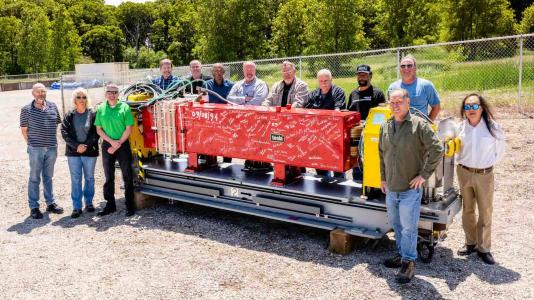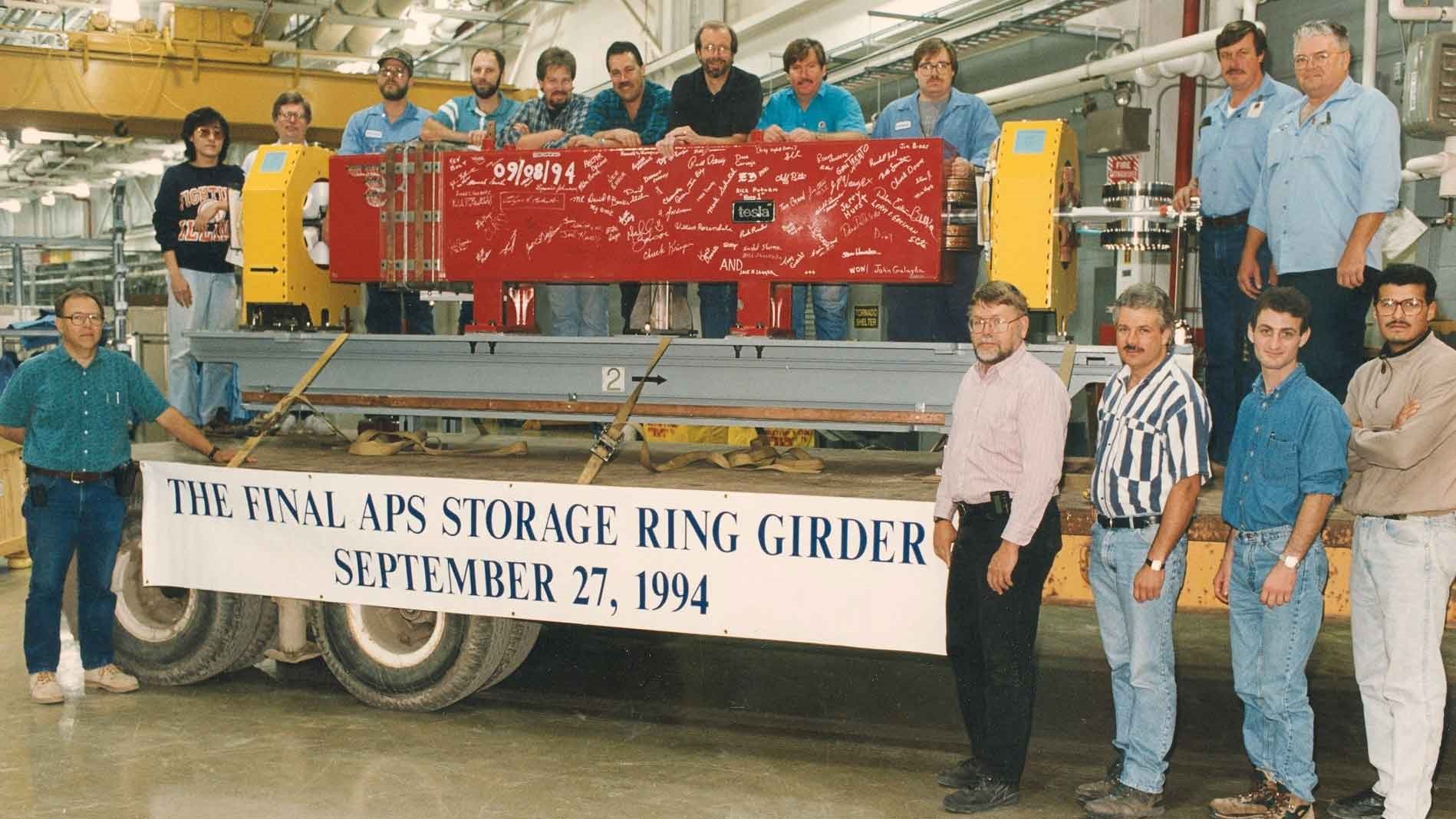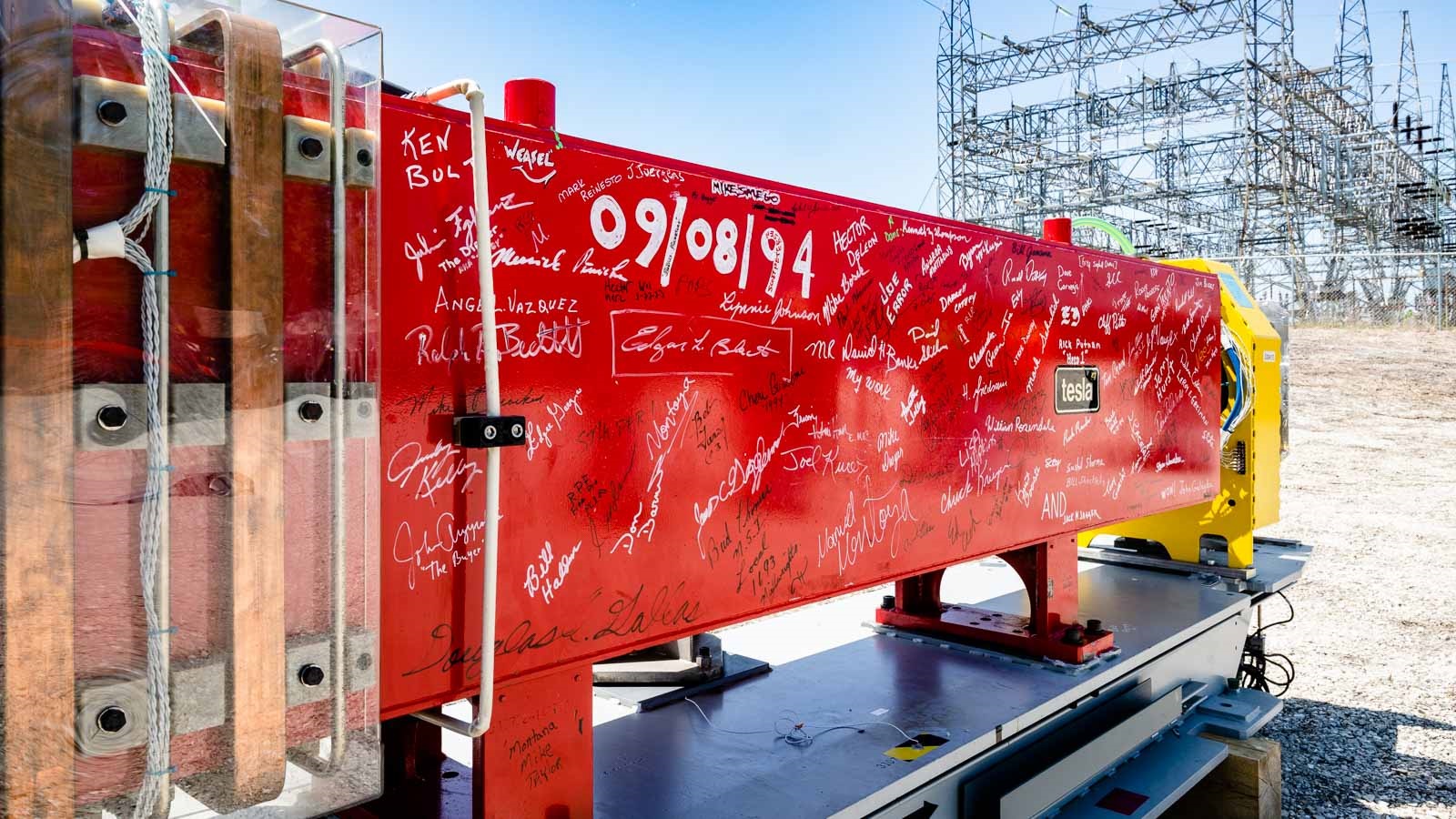In 1994, this magnet — among the last to be installed in the APS — was signed by those who worked on the original facility. In May, the magnet was removed
BY ANDRE SALLES, MARIE GRAY AND MARGUERITE HUBER | JUNE 14, 2023
Many of the Argonne employees who signed the magnet in 1994 still work for the laboratory, and their experiences building the original APS are vital to the ongoing effort to upgrade the facility.

On September 8, 1994, a group of people affixed their signatures in white ink onto a long red magnet. This was the final dipole magnet (of 81, including spares) built and tested for inclusion in a complex machine known as the Advanced Photon Source (APS), a U.S. Department of Energy (DOE) Office of Science user facility at DOE’s Argonne National Laboratory. By sheer chance, it also happened to be part of the final module of magnets to be installed in the APS facility.
Once signed, the magnet took its place next to its fellows and, for the next 28 years, it helped to steer particles called electrons circulating in a large storage ring. Those electrons were manipulated to create bright X-ray beams that thousands of scientists have used over the years to conduct thousands of experiments for the betterment of humankind.
“We expect the new machine to work a hundred times better than the old one. We learned many lessons building the APS, and the best part is that many of the people who learned those lessons are around now to help us build the new one.” — Glenn Decker, APS Upgrade Project
Now the original APS is undergoing an $815 million upgrade, and the original APS storage ring is being removed to make way for a more modern one. And so, on May 23, the signed dipole magnet was taken back out of the storage ring facility, seeing the light of day for the first time in 29 years. As it emerged, it brought with it many memories, emerging fresh in the minds of those who were there in 1994, building a dream machine.
Ralph Bechtold was one of them. In 1994 he worked in the APS magnet factory, turning out designs, prototypes and production models of the magnets used in the storage ring. His is one of the names on this dipole. Nearly three decades later, Bechtold now oversees the assembly of the brand-new magnet modules that will be installed in the storage ring facility later this year.
“Seeing this magnet makes me think of all the people who have gone before,” Bechtold said. “A lot of people who signed it are no longer with us. But I think their legacy is the knowledge that was handed down, which we are now making use of for the upgrade.”

The upgrade of the APS will enhance the brightness of the facility’s already powerful X-ray beams by up to 500 times. Along with new and improved experiment stations, these new beams will allow scientists to peer deeper into materials and capture images at higher resolutions. This will lead to new advancements in battery technology, solar cells, microelectronics and treatments for infectious diseases, to name a few.
Many of those who signed the magnet are, like Bechtold, still working at the APS. Robert Wright, a mechanical engineering specialist with the APS Engineering Support division, remembers working long (but safe) hours in the magnet factory to meet production deadlines during those early days.
“It was a very busy period for many of us,” Wright said. “Most were young and starting families. It’s all a bit of a blur to be honest as it all went by so quickly. Signing the magnet was a milestone at the time, but looking back it was just a blip in the day as we went onto the next thing.”
Wright remembers a quote from Jack Jagger, who headed the magnet group during that initial burst of activity on the APS: “These are the good old days.” Jagger, Wright said, had been through the building of accelerators before, “so he knew that the things we were doing would end up being the stories we would tell years down the road.”
Edmund “Elroy” Chang, who works for the Environment, Safety and Health division at the APS, also signed the magnet, and seeing it again brought back a flood of names and faces.
“Looking at the magnet brought me back to how much effort it took for all these people, all my friends, comrades, to actually get this machine going,” Chang said, “and the successful operation of the APS from 1996 to 2023. Amazing we still have a coterie of people here from that original time. Reminiscing, seeing all this and the success of it, what the object, that magnet represents, is just pretty cool.”
For Ed Russell, seeing the magnet again was a reminder of just how long it has been since he signed it.

“It was really neat seeing the storage ring tunnel empty,” Russell said. “It brought back memories of what it looked like before we started the installation. Quite a few of those who signed the girder are no longer with us, so that was a reality check on how long it’s been — almost 30 years. It was quite a shock to see it coming out.”
Thirty years ago, Russell was a technician helping to install the original APS magnets. Now he’s the manager of the APS building, and he said being involved with the APS is still very exciting.
“I knew getting into the APS would be good,” he said. “When I started at Argonne I spent eight months to a year in High Energy Physics and then transferred to the APS. I knew when I started in 1989 that this is a place to make a career.”
He’s not alone. For Glenn Decker, APS Upgrade associate project manager for accelerators, one of the best parts of working on the new iteration of the APS is tapping into the expertise of his colleagues who, like him, helped to build the original storage ring.
“We expect the new machine to work a hundred times better than the old one,” Decker said. “We learned many lessons building the APS, and the best part is that many of the people who learned those lessons are around now to help us build the new one.”
____________________________________________
The U.S. Department of Energy's APS at Argonne National Laboratory is one of the world’s most productive x-ray light source facilities. Each year, the APS provides high-brightness x-ray beams to a diverse community of more than 5,000 researchers in materials science, chemistry, condensed matter physics, the life and environmental sciences, and applied research. Researchers using the APS produce over 2,000 publications each year detailing impactful discoveries, and solve more vital biological protein structures than users of any other x-ray light source research facility. APS x-rays are ideally suited for explorations of materials and biological structures; elemental distribution; chemical, magnetic, electronic states; and a wide range of technologically important engineering systems from batteries to fuel injector sprays, all of which are the foundations of our nation’s economic, technological, and physical well-being.
Argonne National Laboratory seeks solutions to pressing national problems in science and technology. The nation's first national laboratory, Argonne conducts leading-edge basic and applied scientific research in virtually every scientific discipline. Argonne researchers work closely with researchers from hundreds of companies, universities, and federal, state and municipal agencies to help them solve their specific problems, advance America's scientific leadership and prepare the nation for a better future. With employees from more than 60 nations, Argonne is managed by UChicago Argonne, LLC, for the U.S. DOE Office of Science.
The U.S. Department of Energy's Office of Science is the single largest supporter of basic research in the physical sciences in the United States and is working to address some of the most pressing challenges of our time. For more information, visit the Office of Science website.
